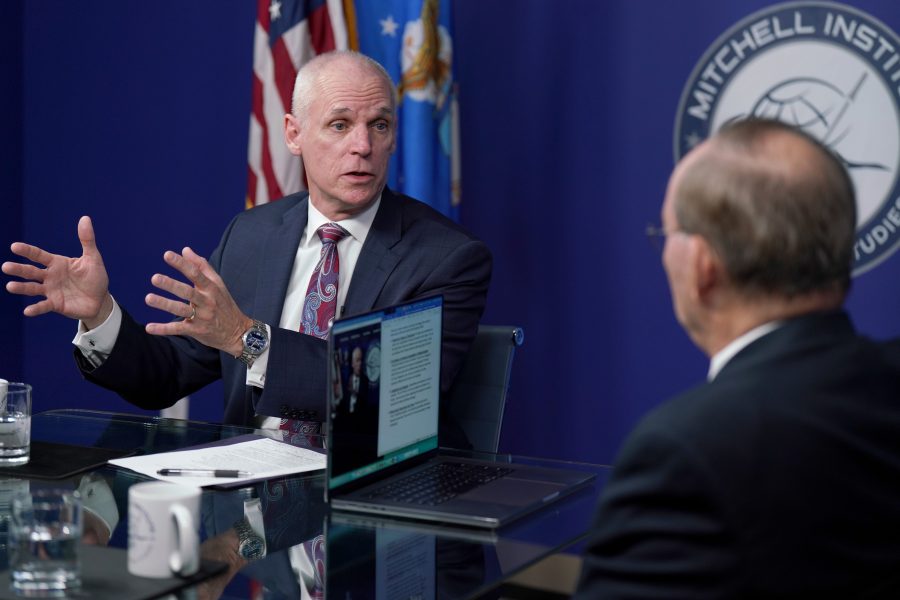The acting official in charge of shaping the future Air Force revealed new details about the service’s plans for its fleet of unmanned wingmen Nov. 15, including the prospect that some of the drones may be aerially refueled to increase their range.
The Air Force is still working through what roles Collaborative Combat Aircraft (CCAs) will play in its future force, starting with the standup of an experimental operations unit that will explore how to use the new drones, Thomas J. Lawhead, the acting head of Air Force Futures, said during an event at the Mitchell Institute for Aerospace Studies.
Lawhead also referred to CCAs as coming in various “increments” or “tranches” as the Air Force advances the concept.
However, some basic details about CCAs are becoming clear after recent comments by Lawhead and Secretary of the Air Force Frank Kendall.
The range of the first set of CCAs “will be relatively the same as our current fighter fleet, potentially a little bit longer, which helps with the flexibility of how we would actually employ them, and we’re working through those concepts of employment right now,” said Lawhead, who serves as the assistant deputy chief of staff for strategy, integration, and requirements, in a conversation with retired Lt. Gen. David A. Deptula, dean of the Mitchell Institute.
Current Air Force fighters have a ferry range of around 1,000-2,000 miles without aerial refueling, though that decreases when pushed hard in combat and carrying weapons.
The Air Force is heavily dependent on aerial refueling to keep its fighters, bombers, and other aircraft in the air for extended periods of time. A future, more fuel-efficient, survivable tanker is in the works as part of the Next-Generation Air-Refueling System (NGAS), showing the Air Force thinks aerial refueling will be a critical part of its shift towards more dispersed and potentially contested operations in the Pacific.
“Future tranches and increments of CCAs will probably be refueled,” Lawhead said. “That adds to their fueling complexity and the fuel needed in theater. But we think those are problems that are solvable going forward.”
The possibility of extended-range, aerially-refueled CCAs in the near term is also an option, Lawhead said.
“There is potential, depending on the offer, for refueling capability in our first CCAs,” he said.
CCAs are designed to increase the capability of manned fighters, such as the F-35 and the future Next Generation Air Dominance fighter (NGAD). Kendall has floated a ballpark figure of 1,000 CCAs that will each cost roughly one-quarter to one-third of the price of an F-35, he said Nov. 13.
The USAF variant of the F-35 costs around $75 million per aircraft. Current Air Force drones, such as the MQ-9 Reaper, cost around $30 million.
Lawhead said the service is still determining whether CCA aircraft will be a part of or separate from manned aircraft squadrons.
The Air Force has to balance the long-standing issue of capability versus cost: the more advanced the platform, the fewer the service will likely be able to buy. Lawhead also hinted that the service may add additional capabilities that complement or are employed by CCAs.
“The other side of that coin, then, is what are the other things we want uncrewed aircraft to do?” he said. “Whether that’s coming out of palletized effects, whether it’s being launched off of fighters, bombers, whether it’s SOF—Special Ops Forces—inserted into the battlespace. We will want sensors, we will want [communication] nodes, we will want non-kinetic effectors out in the battlespace. All of those could be potentially supplied by autonomous platforms.”
But first, the Air Force needs to get started. CCAs are one of 12 so-called “new starts” in the Air Force’s 2024 budget that cannot begin until a budget is passed. Congress is currently operating under a stopgap continuing resolution and looks likely to continue doing so for at least the next couple of months. The Air Force plans to invest around $6 billion in CCAs over the next five years. The Air Force budgeted $72 million in fiscal 2024 for the experimental operations unit Lawhead referenced.
Once the Air Force can finally get started in earnest on CCAs, it will determine whether it wants short-runway or runway-independent CCAs, as well as what payloads they can carry, what missions they can conduct, and “how to elaborate it needs to be,” Lawhead said.
“We will continue to fight to keep the cost of CCA and its mission equipment as low as possible,” he said. “Obviously, once a CCA gets up towards the cost of an F-35, you might as well buy an F-35.”
